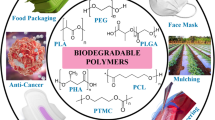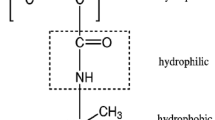Abstract
Polycaprolactone is a biodegradable, biocompatible, and versatile polymer commonly used in the pharmaceutical and biomedical industry and the development of new catalysts that allow for the synthesis under milder reaction conditions and in shorter reaction times is an appealing alternative. The iron-containing imidazolium-based ionic liquid 1-n-butyl-3-methylimidazolium heptachlorodiferrate was able to efficiently catalyze the ring-opening polymerization of ε-caprolactone under mild reaction conditions. Polymerization yields higher than 80% were obtained after 4 h of reaction at temperatures up to 85 °C, using low ionic liquid:ε-caprolactone molar ratios (1:720 − 1:1500), in the absence of solvent and without an intentionally added alcohol as an initiator. Semi-crystalline polycaprolactones, with molecular weights up to 14 kDa and narrow molecular weight distributions were synthesized. The chemical structure of the polymer was confirmed by Nuclear Magnetic Resonance (1H NMR) and Fourier Transform Infrared (FTIR) spectroscopy, and its crystalline content was estimated from the enthalpy of melting of the differential scanning calorimetry (DSC) thermogram. Finally, a caprolactone-activated ROP mechanism mediated by the ionic liquid was suggested.







Similar content being viewed by others
Availability of data and material
The datasets generated during the current study are available from the corresponding author on request.
Code availability
Not applicable.
References
Labet M, Thielemans W (2009) Synthesis of polycaprolactone: A review. Chem Soc Rev 38:3484–3504. https://doi.org/10.1039/b820162p
Malikmammadov E, Tanir TE, Kiziltay A, Hasirci V, Hasirci N (2018) PCL and PCL-based materials in biomedical applications. J Biomater Sci Polym Ed 29:863–893. https://doi.org/10.1080/09205063.2017.1394711
Jenkins MJ, Harrison KL (2006) The effect of molecular weight on the crystallization kinetics of polycaprolactone. Polym Adv Technol 17:474–478. https://doi.org/10.1002/pat.733
Nava-Arzaluz MG, Piñón-Segundo E, Ganem-Rondero A, Lechuga-Ballesteros D (2012) Single emulsion-solvent evaporation technique and modifications for the preparation of pharmaceutical polymeric nanoparticles. Recent Pat Drug Deliv Formul 6:209–223. https://doi.org/10.2174/187221112802652633
Danaei M, Dehghankhold M, Ataei S, Hasanzadeh Davarani F, Javanmard R, Dokhani A, Khorasani S, Mozafari M (2018) Impact of particle size and polydispersity index on the clinical applications of lipidic nanocarrier systems. Pharmaceutics 10:57. https://doi.org/10.3390/pharmaceutics10020057
Oshimura M, Okazaki R, Hirano T, Ute K (2014) Ring-opening polymerization of ɛ-caprolactone with dilithium tetra-tert-butylzincate under mild conditions. Polym J 46:866–872. https://doi.org/10.1038/pj.2014.76
Arbaoui A, Redshaw C (2010) Metal catalysts for ε-caprolactone polymerisation. Polym Chem 1:801–826. https://doi.org/10.1039/b9py00334g
Varma IK, Albertsson A-C, Rajkhowa R, Srivastava RK (2005) Enzyme catalyzed synthesis of polyesters. Prog Polym Sci 30:949–981. https://doi.org/10.1016/j.progpolymsci.2005.06.010
Kobayashi S (2015) Enzymatic ring-opening polymerization and polycondensation for the green synthesis of polyesters. Polym Adv Technol 26:677–686. https://doi.org/10.1002/pat.3564
Gazeau-Bureau S, Delcroix D, Martín-Vaca B, Bourissou D, Navarro C, Magnet S (2008) Organo-catalyzed ROP of ϵ-caprolactone: Methanesulfonic acid competes with trifluoromethanesulfonic acid. Macromolecules 41:3782–3784. https://doi.org/10.1021/ma800626q
Shibasaki Y, Sanada H, Yokoi M, Sanda F, Endo T (2000) Activated monomer cationic polymerization of lactones and the application to well-defined block copolymer synthesis with seven-membered cyclic carbonate. Macromolecules 33:4316–4320. https://doi.org/10.1021/ma992138b
Zhu N, Liu Y, Liu J, Ling J, Hu X, Huang W, Feng W, Guo K (2018) Organocatalyzed chemoselective ring-opening polymerizations Sci Rep 8:3734. https://doi.org/10.1038/s41598-018-22171-6
Veneral JG, de Oliveira D, Ferreira SRS, Oliveira JV (2018) Continuous enzymatic synthesis of polycaprolactone in packed bed reactor using pressurized fluids. Chem Eng Sci 175:139–147. https://doi.org/10.1016/j.ces.2017.09.037
Zhao H, Nathaniel GA, Merenini PC (2017) Enzymatic ring-opening polymerization (ROP) of lactides and lactone in ionic liquids and organic solvents: Digging the controlling factors. RSC Adv 7:48639–48648. https://doi.org/10.1039/C7RA09038B
Albertsson A-C, Srivastava RK (2008) Recent developments in enzyme-catalyzed ring-opening polymerization. Adv Drug Deliv Rev 60:1077–1093. https://doi.org/10.1016/j.addr.2008.02.007
Vijayakrishna K, Manojkumar K, Sivaramakrishna A (2015) In: Mecerreyes D (ed) Applications of ionic liquids in polymer science and technology, Springer, Berlin, Heidelberg. https://doi.org/10.1007/978-3-662-44903-5_13
Kaoukabi A, Guillen F, Qayouh H, Bouyahya A, Balieu S, Belachemi L, Gouhier G, Lahcini M (2015) The use of ionic liquids as an organocatalyst for controlled ring-opening polymerization of ϵ-caprolactone. Ind Crops Prod 72:16–23. https://doi.org/10.1016/j.indcrop.2015.02.002
Abdolmaleki A, Mohamadi Z (2013) Acidic ionic liquids catalyst in homo and graft polymerization of ε-caprolactone. Colloid Polym Sci 291:1999–2005. https://doi.org/10.1007/s00396-013-2941-x
Rodrigues TS, Machado F, Lalli PM, Eberlin MN, Neto BAD (2015) Styrene polymerization efficiently catalyzed by iron-containing imidazolium-based ionic liquids: Reaction mechanism and enhanced ionic liquid effect. Catal Commun 63:66–73. https://doi.org/10.1016/j.catcom.2014.11.002
Alves RC, Agner T, Rodrigues TS, Machado F, Neto BAD, da Costa C, de Araújo PHH, Sayer C (2018) Cationic miniemulsion polymerization of styrene mediated by imidazolium based ionic liquid. Eur Polym J 104:51–56. https://doi.org/10.1016/j.eurpolymj.2018.04.035
Patrocinio VMB, Agner T, Dutra GVS, Machado F, Neto BAD, Araújo PHH, Sayer C (2019) High molecular weight polystyrene obtained by cationic emulsion polymerization catalyzed by imidazolium-based ionic liquid. Macromol React Eng 13:1800061. https://doi.org/10.1002/mren.201800061
Agner T, Zimermann A, Machado F, Neto BAD, Araújo PHH, Sayer C (2020) Thermal performance of nanoencapsulated phase change material in high molecular weight polystyrene. Polímeros Ciência e Tecnol 30:e2020013. https://doi.org/10.1590/0104-1428.01320
Kricheldorf HR, Kreiser-Saunders I, Damrau D-O (1999) Resorbable initiators for polymerizations of lactones. Macromol Symp 144:269–276. https://doi.org/10.1002/masy.19991440124
Schindler A, Hibionada YM, Pitt CG (1982) Aliphatic polyesters. III. Molecular weight and molecular weight distribution in alcohol-initiated polymerizations of ε-caprolactone. J Polym Sci Polym Chem Ed 20:319–326. https://doi.org/10.1002/pol.1982.170200206
Sobczak M (2012) Ring-opening polymerization of cyclic esters in the presence of choline/SnOct2 catalytic system. Polym Bull 68:2219–2228. https://doi.org/10.1007/s00289-011-0676-8
Ikada Y, Tsuji H (2000) Biodegradable polyesters for medical and ecological applications. Macromol Rapid Commun 21:117–132. https://doi.org/10.1002/(sici)1521-3927(20000201)21:3%3c117::aid-marc117%3e3.0.co;2-x
Elzein T, Nasser-Eddine M, Delaite C, Bistac S, Dumas P (2004) FTIR study of polycaprolactone chain organization at interfaces. J Colloid Interface Sci 273:381–387. https://doi.org/10.1016/j.jcis.2004.02.001
Zhong C, Sasaki T, Jimbo-Kobayashi A, Fujiwara E, Kobayashi A, Tada M, Iwasawa Y (2007) Syntheses, structures, and properties of a series of metal ion-containing dialkylimidazolium ionic liquids. Bull Chem Soc Jpn 80:2365–2374. https://doi.org/10.1246/bcsj.80.2365
Zhang L, Fu X, Gao G (2011) Anion-cation cooperative catalysis by ionic liquids. ChemCatChem 3:1359–1364. https://doi.org/10.1002/cctc.201100016
de Oliveira VM, Silva de Jesus R, Gomes AF, Gozzo FC, Umpierre AP, Suarez PAZ, Rubim JC, Neto BAD (2011) Catalytic aminolysis (amide formation) from esters and carboxylic acids: Mechanism, enhanced ionic liquid effect, and its origin. ChemCatChem 3:1911–1920. https://doi.org/10.1002/cctc.201100221
Sarkar A, Roy SR, Chakraborti AK (2011) Ionic liquid catalysed reaction of thiols with α, β-unsaturated carbonyl compounds—remarkable influence of the C-2 hydrogen and the anion. Chem Commun 47:4538–4540. https://doi.org/10.1039/c1cc10151j
Ramos LM, Guido BC, Nobrega CC, Corrêa JR, Silva RG, de Oliveira HCB, Gomes AF, Gozzo FC, Neto BAD (2013) The Biginelli reaction with an imidazolium-tagged recyclable iron catalyst: Kinetics, mechanism, and antitumoral activity. Chem - A Eur J 19:4156–4168. https://doi.org/10.1002/chem.201204314
Acknowledgements
The authors thank the financial support from CAPES − Coordenação de Aperfeiçoamento de Pessoal de Nível Superior, Finance Code 001 and CAPES PRINT Program (Project Number: 88887.310560/2018-00), and CNPq − Conselho Nacional de Desenvolvimento Científico e Tecnológico. The authors also thank the Analysis Center of Chemical Engineering and Food Engineering Department from the Federal University of Santa Catarina for the DSC analysis.
Author information
Authors and Affiliations
Corresponding author
Ethics declarations
Conflicts of Interest
The authors have no conflicts of interest to declare.
Additional information
Publisher's Note
Springer Nature remains neutral with regard to jurisdictional claims in published maps and institutional affiliations.
Rights and permissions
About this article
Cite this article
Leite, M.J., Agner, T., Machado, F. et al. ε-caprolactone ring-opening polymerization catalyzed by imidazolium-based ionic liquid under mild reaction conditions. J Polym Res 29, 56 (2022). https://doi.org/10.1007/s10965-022-02891-0
Received:
Accepted:
Published:
DOI: https://doi.org/10.1007/s10965-022-02891-0




